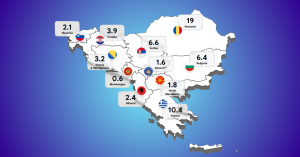As the world grapples with the effects of climate change and pressure to design a more sustainable roadmap for humanity increases, we expect technology to continue to play a pivotal role in driving sustainable solutions. Currently, we’re not moving at the pace set by international agreements for reducing greenhouse gas emissions. While policy changes, behavioral shifts, and conservation efforts are important components, technology provides additional tools needed to address the scale and complexity of the challenges we face. Simply put, we’ll continue to go too slow without supporting and scaling climate technology.
So far in 2023, global and European climate tech funding has experienced a macro gravitational pull, dropping together with the overall venture market. Going forward, however, we expect to see the wide range of climate tech companies previously funded by investors seek growth funding, while newcomers climb the ladder, some with faster tailwinds than others.
Having watched the space closely for the past few years, The Recursive made a list of the key climate tech trends and solutions that we expect to drive the attention of investors and customers in 2024.
#1 Smart Mining
One pivotal climate trend shaping in 2024 is smart mining. As the global challenge of climate change requires heightened urgency of action, industries – especially those viewed as environmental liabilities – are relying more heavily on technology as a critical lever for progress.
Increasing efficiency in the mining sector is particularly key as consumption and production of goods relying on mining exploration continues to increase. Trends such as the use of AI, blockchain, smart consumer technology, and the electrification of transportation and the energy sector are likely to continue to increase, and with them, the demand for critical minerals and metals will skyrocket.
Recently, AI has been making inroads into the mining industry, a sector under scrutiny for the risks it poses to the environment and human safety. With AI, we are starting to see the advent of smart mining, whereby intelligent systems help minimize the negative environmental and social impact of traditional mining operations. For instance, the use of advanced machine learning algorithms allows for optimization of extraction processes, energy consumption, and waste creation. They analyze data to identify optimization opportunities and improve the efficiency of operations and resource use as a result. Further, AI is used to identify areas where the impact of mining operations can be minimized.
AI is not the only disruptive technology in the mining industry. Advanced robots and remote-controlled equipment are further pushing the boundaries of underground mining. Their use aims to protect human lives, and also eliminate noise, reduce the impact of exhaust gasses, and reduce the overall carbon footprint of exploitation processes.
So far, we discussed Earth-bound mining, but the future of mining may take us farther: among the stars. Companies are actively exploring the possibility of asteroid mining and in-space material sourcing, with first missions scheduled in the near future. To that end, companies are building specialized spacecrafts and planning to build space mining infrastructures that would decrease dependency on limited, Earth-sourced elements.
Tech giants, startups, and investors and stakeholders are taking note of the potential to transform the mining industry. Mining firms are expected to spend $218M on AI platforms worldwide by 2024. Take the example of Microsoft and mining company BHP: they use real-time data from the copper concentrators and Azure Machine Learning to make hourly predictions and advise the operations team. Up-and-coming startups such as Minerva Intelligence in the US, Earth AI in Australia, and StartumAI in Canada are further building solutions for AI-based mining. Meanwhile, the asteroid mining market is projected to grow at a CAGR of 25% by 2030, to approximately $6 billion. In Central and Eastern Europe, and particularly Bulgaria, there is already a strong foundation for space technology innovations, and asteroid mining is in the cards with companies such as Varda Space Industries leading the way.
Smart Mining Solutions in CEE: DOK-ING, Varda Space Industries, ARCA Space
#2 Heat and Fire Mitigation Solutions
Through 2023, our warming planet has been sending stronger signals than ever before. As people suffocated and even lost their lives amid heating waves and intense wildfires, the world grew acutely aware of the escalating threat of climate change. The increasing intensity and frequency of heat-related weather events have rendered our traditional methods of combating these natural disasters obsolete.
As a result, we expect to see skyrocketing interest in heat and fire mitigation solutions going forward. Such technologies range from fire prevention to heat mitigation and cooling technologies.
AI-driven predictive modeling, satellite-based monitoring, and advanced firefighting drones improve our ability to both prevent and respond to fire-related catastrophes. On the preventive side, satellite data, remote-sensing technology, and AI algorithms taken together gather and analyze massive sets of climate data and indicate high-risk areas for wildfires. This in turn enables early interventions in the respective areas. Electro-optical and infrared sensors and enhanced smoke detection algorithms can further enable rapid responses to developing fires and mitigate their effects.
Meanwhile, in the cities, urban planners employ innovative technologies and nature-based solutions to prevent and reduce the heat island effect in densely populated areas. These include heat mapping and thermal imaging technologies, which can detect heat leaks in buildings, thus helping owners prevent energy losses. Other solutions include urban green technologies such as green spaces and green roofs, and the use of reflective materials on roofs, facades, and pavements – all of which can help prevent heat accumulation. In fact, we have already seen cities in the US or Spain adopting such solutions to get relief from the 2023 heatwaves.
Cooling technologies are another hot area of innovation and investment. Here, advances in technology target the decrease in the energy consumption and cost of equipment, to avoid a counterproductive cycle of carbon emissions generation. As such, we’re seeing a wave of sustainable air conditioning technologies, such as advanced heat pumps using alternatives to refrigerants and energy-efficiency thermostats.
Heat and Fire Mitigation Solutions in CEE: Telelink Infra Services, Aspires, Lirex, Probotek, Fireproov, Robotic Cats
#3 Digital Twins
Imagine a virtual replica of a product before it has been built, or a factory, or even an entire city. Now imagine that it is so precise it can predict the resource and energy consumption of the entire product or system, down to the exact carbon emissions expected from its development and use. Digital twins bring this scenario to life by offering highly accurate digital representations of physical systems. This in turn enables real-time monitoring, analysis, and optimization of systems across various industries and sectors, from smart cities to renewable energy installations.
In the context of climate change, digital twins serve as an analytical sandbox: they allow stakeholders to simulate and analyze the environmental impact of various scenarios before implementing changes in the real world. Urban planners, for instance, can use digital twins to model the effects of green mobility alternatives such as bike lanes, while energy companies can analyze how the placement and operation of renewable energy sources can reduce waste and boost efficiency.
The use of digital twins is all the more relevant in the context of an ongoing – and accelerating – clean energy transition that is challenged by logistics and operational problems. As we look ahead to 2024, we expect to see considerable attention from investors, governments, and product companies into digital twin solutions that serve climate goals, due to their efficiency and scalability. Moreover, AI advances are poised to further enhance the predictive capabilities of digital twins, offering even more nuanced solutions.
Digital Twin Solutions in CEE: MYX Robotics, MClimate
#4 Carbon Capture, Utilization, and Storage (CCUS)
CCUS technologies hold great potential to mitigate climate change by capturing, utilizing, and storing carbon dioxide (CO2), one of the main contributors to greenhouse gas emissions. Among the current range of CO2 removal technologies, direct air capture (DAC) is best positioned to remove CO2 from the atmosphere, due to its independence from the origin of emissions and the lack of restriction in stationing the machines.
So far, only 0.1% of carbon dioxide removal from the atmosphere is attributed to CCUS technologies, largely due to the lack of scalability of such projects. Forests are a much stronger lever, yet one that cannot account for the carbon removal targets we set out to achieve.
The current tailwinds, however, are favoring further CCUS technology development and deployment. Substantial financing has been unlocked for projects that can launch CCUS technologies into the mainstream, including governmental grants, VC bets, corporate funds, and startup programs. The International Energy Agency (IEA) forecasts that DAC technologies will be removing 90 million tonnes of CO2 a year in 2030, then 980 million tonnes by 2050.
Direct air capture technology is also getting more political support around the world, as countries develop policy environments that can evaluate the regulatory, economic, and technological opportunities for carbon dioxide removal.
Carbon Capture, Utilization, and Storage Solutions in CEE: Green Sequest (Poland), Carbon Miner (Ukraine)
Bonus: consult our listicle for more CCSU solutions from CEE.
#5 Carbon Accounting Software
Why is carbon accounting an essential part of the fight against climate change? Because it is a support tool for businesses and organizations to get onboard of this mission, by giving a solid understanding of what is their impact and how they can improve it. Carbon accounting software helps companies measure, manage, and report their carbon, as well as other greenhouse gas emissions.
Equipped with advanced analytics and data integration capabilities, carbon accounting software is becoming indispensable for organizations aiming to track their carbon footprints and set reduction targets.
In 2024, we expect to see more software solutions popping up (from both the startup and the corporate world), offering improved accuracy, real-time monitoring, and enhanced reporting features, as they take advantage of increased AI capabilities and democratized access to these advancements. Forecasts show the global carbon accounting software market size growing from $15.31 billion in 2023 to $64.39 billion by 2030, at a CAGR of 22.8%.
Carbon Accounting Software Solutions in CEE: Plan A (Bulgaria), EKYO (Romania), Envirly (Poland)
#6 Climate Fintech
Climate fintech is emerging as one of the strongest innovation areas for European startups. In 2022, Europe secured approx. $1 billion in climate tech funding, surpassing North America by 56%.
So far, finance has been one of the big disconnects in the sustainable economy transition, with investments still flowing to incumbents and commitments towards green finance not being lagging behind.
As the finance industry is seeking ways to embrace sustainable practices and investing in climate-friendly initiatives, climate fintech platforms emerge to facilitate the allocation of capital towards sustainable projects. These often include renewable energy installations, green infrastructure development, and sustainable agriculture. Climate tech platforms are leveraging up-and-coming technologies such as artificial intelligence and blockchain to enhance transparency, streamline investments, and promote sustainable finance.
We expect to see more players in the space in 2024, especially in Central and Eastern Europe, where there is a strong tradition in both fintech and agriculture. For instance, Estonia may have the highest number of climate fintechs with at least one female co-founder.
Climate Fintech Solutions in CEE: eAgronom (Estonia), Grünfin (Estonia)
#7 Clean Energy
The global transition to clean energy sources will continue to accelerate in 2024 and beyond. The IEA expects global investments in clean energy technologies, including solar, wind, hydropower, geothermal, and nuclear, to rise faster than investment in fossil fuels between 2021 and 2023, with 24% vs. 15%. Out of a total of $2.8 trillion investment expected in energy in 2023, $1.7 trillion would go to clean energy.
The tailwinds behind this momentum are likely to continue in 2024: the EU as well as other global leaders have been enhancing their policy support for clean energy and placing a focus on industrial strategy to achieve energy independence and economic competitiveness.
Meanwhile, clean energy technologies continue to evolve, improving efficiency, accessibility, and adaptability. If the first wave of innovations in renewable energy concerned hardware, the second wave, currently under our feet, brings software that can optimize energy production and consumption. We expect to see more and more solutions leveraging big data, IoT, and artificial intelligence to help companies serve the increasing demand for clean energy.
Clean Energy Solutions in CEE: Woltair (Czech Republic), Perceptual Robotics (Greece)
Bonus: read about the potential of the Balkans for renewable energy.
#8 Battery Development
The aforementioned scalable deployment of clean energy together with the electrification of transport systems vastly depend on the availability of energy storage solutions, such as advanced batteries.
We expect countries are increasing their production capacities. In Europe, countries such as Poland and Hungary, as well as Sweden, Germany, and France are leading the charts in battery manufacturing capacity, and are expected to continue to increase production ahead of increased demand from the automotive and energy sectors.
Moreover, battery technologies will continue to make significant advancements. Lithium-ion batteries, currently the predominant technology in portable electronics and electric vehicles, are being optimized for energy density, cost, and safety. In addition, emerging battery technologies like solid-state batteries, flow batteries, lithium-sulfur batteries, and ultracapacitors offer further improvements in power density, charging and discharging, and lifetime.
In 2021, the European Commission launched calls for proposal for battery research projects totaling €160 million under its second battery-related Important Project of Common European Interest (IPCEI). Over 110 industrial battery projects and 20 battery cells gigafactories are currently being developed across EU Member states, as the EU aims to meet 69% of its demand for batteries by 2025, and 89% by 2030.
Battery Development Solutions in CEE: Skeleton Technologies (Estonia)
Bonus: see why CEE countries are in top five battery manufacturers worldwide.
#9 Precision Agriculture
Precision agriculture aims to minimize the environmental impact of farming while maximizing productivity and resource efficiency. These two goals make it the single most powerful trend in the modern agricultural industry.
To optimize resource management, reduce inputs, and increase crop yields, precision agriculture is powered by a mix of technologies including satellites, drones, IoT, and artificial intelligence. AI-driven algorithms, for instance, can analyze data on soil conditions, plant health, and weather forecasts to provide actionable insights for precise irrigation, fertilization, and pest management.
As climate change effects including droughts and soil erosion intensify, the question of food security becomes more pressing, and supporting farmers an increasing priority for financiers. The global precision agriculture market is expected to reach $14.61 billion by 2027, growing at a 13.12% CAGR between 2022-2027. Based on success stories from previous years (including the recent acquisition of €101 million of Greek precision agritech startup Augmenta) , we expect to continue seeing investors planting their money in agritech solutions such as crop analytics, artificial intelligence, IoT, and farm management software.
Precision Agriculture Solutions in CEE: AgriCloud (Romania), NIK (Bulgaria)
Bonus: discover 25+ agritech startups in Central and Eastern Europe.
#10 Alternative Protein
Conventional animal agriculture has been shaken in the past few years by the pressing need to address its large contribution to greenhouse gas emissions. Livestock farming accounts for no less than 14.5% of GHG, including carbon dioxide but also methane and nitrous oxide.
Another trend pushing for the production of alternative protein sources concerns animal ethics and consumers’ decision to spare animal lives through their dietary habits. Add to that a growing concern for the health risks posed by frequent meat consumption and a growing population and you have the perfect storm for the growth of the alternative protein industry.
By 2031, the global plant-based dairy and meat alternative market is expected to reach $166 billion, given headwinds such as: a greater availability across retailers, lower price gap vs. animal products, increasing spending power of younger generations with a greater interest in vegetarian/vegan lifestyles, as well as improved technologies and processes in the production of alternative proteins.
Advancements in cellular agriculture, for instance, are making waves recently, with the US FDA giving the green light to cell-based meat consumption and Europe expected to follow in the next few years.
Investors are following the space with an increased appetite: alternative protein startups raised $2.9 billion in investments in 2022, 21 percent of all-time investment.
Alternative Protein Solutions in CEE: Mewery (Czech Republic), Bluana Foods (Romania)








